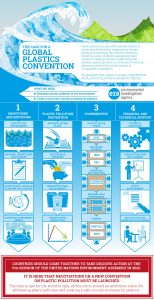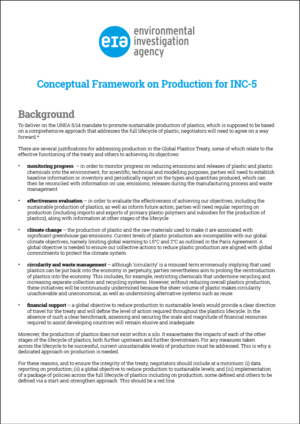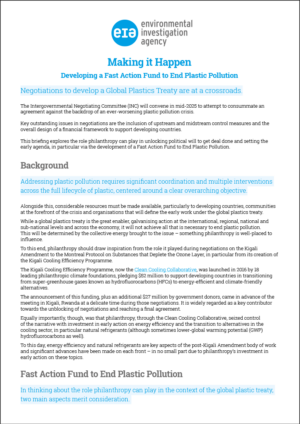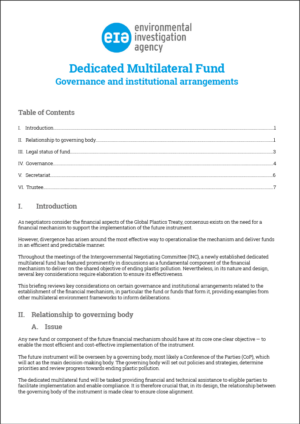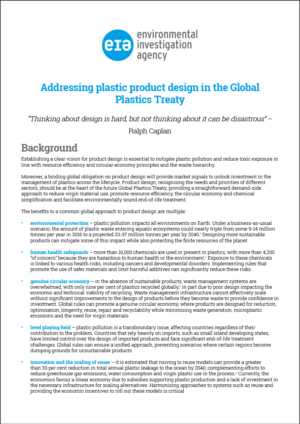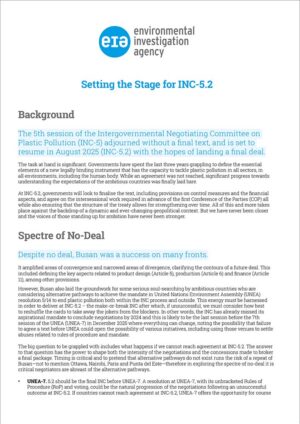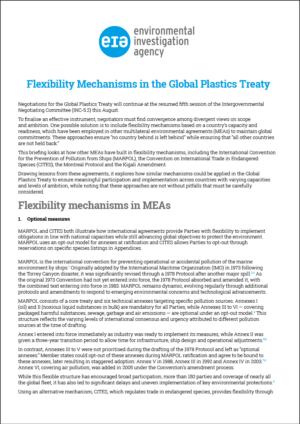Why do we need a new global treaty on plastics?
Addressing the plastic pollution crisis is beyond the ability of any one country, region or sector, and requires an international response. Preventing plastic pollution will require a dedicated global framework, a Convention on Plastic Pollution, that addresses the full lifecycle of plastics from upstream (production) and midstream (design) to downstream (waste management) stages. We need a Convention (a treaty) that builds upon and complements existing national and regional initiatives while addressing the significant gaps that prevent us from eliminating plastic pollution.
The UN Environment Assembly (UNEA) resolution (decision) on 2nd March 2022 entitled ‘End plastic pollution: Towards an international legally binding instrument’ laid out plans for a series of five Intergovernmental Negotiating Committee (INC) meetings to develop a Global Plastics Treaty, and was set to conclude in 2024. However, the 5th session (INC-5) adjourned without a final text, and is set to resume in August 2025 (INC-5.2) with the hopes of landing a final deal. EIA and our partners are continuing to play our critical role as thought leaders and advisors, helping to hold those with power to account. EIA continues to work tirelessly to help shape the outcome of the treaty to ensure it prevents and eliminates, rather than simply ‘reduces,’ plastic pollution.
What Would a Convention on Plastic Pollution Look Like?
To truly end plastic pollution, the international community will require a dedicated global framework, a Convention on Plastic Pollution or ‘Global Plastics Treaty’, that addresses the full lifecycle of plastics from production and design to waste prevention and management.
EIA has contributed to the vision of what a new treaty could look like from its early stages of inception and development, participating in the United Nations-led expert groups tasked with identifying approaches to ending plastic pollution. In 2020, our ‘Thought Starter’ outlined the key elements of design for the future treaty.
Since the adoption of the UNEA resolution to establish an ‘Intergovernmental Negotiating Committee’ (INC), EIA has developed a series of briefings titled ‘Essential Elements’ to further explore key aspects of the future Treaty.
You can find further context on issues related to the treaty at our ‘Essential Elements’ series page.
Podcasts
In this episode, EIA Ocean Campaign Leader Christina Dixon and Ocean Campaigner Jacob Kean-Hammerson join Senior Press & Communications Officer Paul Newman to talk about what went wrong in Busan and contemplate what may happen next.
In this episode, EIA Ocean Campaign Leader Christina Dixon and Ocean Campaigner Jacob Kean-Hammerson join Senior Press & Communications Officer Paul Newman for an update on the progress so far and a look ahead to the challenges remaining for negotiators in Busan.
In this EIA podcast from 2020 our Senior Lawyer and Policy Advisor, Tim Grabiel, takes us on a journey from fossil fuels to waste disposal, explaining why we urgently need to change our approach to plastics.
FAQ: Why do we need a global agreement on plastic pollution?
Still have questions? In our FAQ below you can find our position on the most commonly asked questions about our international plastics work.
Plastic pollution is pervasive and its sources are numerous. The reach and depth of the contamination of our ocean is horrifying. Microplastics have now been documented in all marine habitats – from the ocean surface and sea ice to the seabed – and are ingested by species throughout the marine food chain. They have been detected in the air we breathe, the water we drink and the food we eat. It is now widely accepted that the crisis of plastics in our oceans comes from further upstream. It is an issue of over production and consumption of plastics.
While improvements to waste management are essential, the exponential growth trends in plastic= production mean that we cannot recycle our way out of this problem. No recycling system in the world could deal with the sheer volume of plastic currently consumed around the world daily, which inevitably leads to millions of tonnes being landfilled, incinerated and leaking into the natural environment. The only long-term, comprehensive way to address plastic pollution is to address its root cause – turning off this relentless tap of plastic flooding onto the market every day.
Addressing the plastic pollution crisis is beyond the ability of any one country or region or sector, necessarily requiring a coordinated international response. No such framework currently exists to coordinate action at a global level, as confirmed by an in-depth review by UN Environment which concluded that “no global agreement exists to specifically prevent marine plastic litter and microplastics or provide a comprehensive approach to managing the lifecycle of plastics.”[1]
As such, political momentum for a new global agreement grew. Several recent high-level regional and ministerial declarations, including: the Nordic Ministerial Declaration, [2] Caribbean and Community and Common Market (CARICOM) St. Johns Declaration, [3] The Durban Declaration, [4] and the new European Union (EU) Circular Economy Action Plan[5] called for a legally binding global treaty. This culminated in March 2022 with governments of the world agreeing to UNEA Resolution 5/14 ‘End Plastic Pollution: Towards and international legally binding instrument’.
The legislative gap must now be filled, and these aspirations met, by a new legally binding agreement on plastic pollution with power to address the problem at source by putting a cap on plastic production.
[1] UN Environment, Combating Marine Plastic Litter and Microplastics: An Assessment of the Effectiveness of Relevant International, Regional and Subregional Governance Strategies and Approaches (15 February 2018), UNEP/EA.3/INF/5, p. 105.
[2] Nordic Co-operation. (2019). Nordic ministerial declaration on the call for a global agreement to combat marine plastic litter and microplastics. Nordic Co-operation official website. Accessed 23rd March 2020. Available here.
[3] Market Screener (2019). CARICOM Caribbean Community: Communiqué issued at the conclusion of the fortieth regular meeting of the conference of heads of government of the Caribbean community. Market Screener website. Accessed 30th March 2020. Available here.
[4] African Ministerial Conference on the Environment (AMCEN). Report of the ministerial segment. (Durban, November 2019). AMCEN/17/9. Available here.
[5] European Commission. A new Circular Economy Action Plan for a cleaner and more competitive Europe. (Brussels, 11th March 2020). COM(2020) 98 final. Available here.
The United Nations Environment Assembly (UNEA) is the highest-level decision-making body on the environment at the global level. It meets in Nairobi every two years to set priorities for global environmental policies and develop international environmental law. It is attended by policy makers, industry, experts and NGOs from all over the world.
UNEA had been exploring how to tackle marine plastic pollution through a special group (known as an Ad Hoc Open-Ended Expert Group) for several years. The resumed 5th session (UNEA-5.2) taking place in 28th February – 2nd March 2022 where a critical next step towards agreeing a new global framework was taken. It is at this conference all Member States agreed by consensus to adopt Resolution 5/14 “End plastic pollution: towards an international legally binding instrument”. This resolution established an intergovernmental negotiating committee (INC) which was tasked with creating a legally binding global instrument.
EIA believes that the new legally binding agreement should be based on four pillars of action.
- Pillar 1: Monitoring and Reporting. Monitoring and reporting on the state of the environment and implementation will be key in understanding the relative success of the treaty. EIA believe that the evolution of two key indicators should form the cornerstone of these activities:
- Presence of Plastic Pollution – Environmental Monitoring: the presence of plastic pollution in the environment, e. tracking the evolution of plastic in the marine and other environment over time
- Circular Economy and Leakage – Data Reporting: plastic inputs into the environment, e. tracking national progress towards a circular economy and the reduction of plastic leakage into the environment.
- Pillar 2: Plastic Pollution Prevention. Preventing plastic pollution from entering the environment will require measures that go beyond the scope of existing conventions and agreements – for instance, the power to ban certain single-use plastic products, and putting restrictions on new plastic production (particularly those that are hard to recycle or used in single-use applications) and toxic additives.
- Pillar 3: Coordination. There are several existing international conventions and agreements that can make decisions relevant to particular aspects of plastic pollution – such as the toxicity of certain chemicals found in plastics under the Stockholm Convention, international trade of plastic waste under the Basel Convention, or disposal of waste from ships under MARPOL. These are separate bodies with their own mandates and jurisdictions, but coordination is needed to align efforts.
- Pillar 4: Technical and Financial Support. All decisions will need to be based on the best scientific evidence and socio-economic assessment, and some countries will require financial assistance to tackle different aspects of the plastic problem. As such, technical and financial resources will be needed to support decision-making and assist developing countries and economies in transition.
The UNEA mandate that provides the guiderails for the negotiations – stating that the negotiations should conclude by the end of 2024, with a Diplomatic Conference of the Plenipotentiaries (where member states will sign the treaty signifying their intention to ratify the future treaty) to occur in 2025. However, at the final scheduled meeting of the INC negotiators failed to finalise a deal. The fifth session will therefore resume in 2025 with a view to finalising the talks.
However, finalising the treaty text will not mean that the treaty will enter into force. Signing the treaty is only an expression of intent and itself not binding. Multilateral Environmental Agreements typically include provisions that mean the convention only enters into force when enough countries have ratified the treaty. Ratification occurs when states have received internal approval through government and notify other parties that they have consented to be bound by the treaty. This can take several years, making the speed of ratification a crucial element of the process.
Yes and no.
A number of international Conventions exist that are relevant for tackling different aspects of marine plastic pollution, including the Stockholm and Basel Conventions and MARPOL, as well as various Regional Seas Conventions. There is also a variety of national and regional (e.g. EU level) legislation in different countries.
However, this jigsaw of pieces does not complete the puzzle. A comprehensive study by UN Environment concluded, “[n]o global agreement exists to specifically prevent marine plastic litter and microplastics or provide a comprehensive approach to managing the lifecycle of plastics”.[1] To fill these gaps in global governance will require the negotiation and adoption of a new global agreement.
[1] UN Environment, Combating Marine Plastic Litter and Microplastics: An Assessment of the Effectiveness of Relevant International, Regional and Subregional Governance Strategies and Approaches (15 February 2018), UNEP/EA.3/INF/5, p. 15
Some sources suggest that swapping plastic for other materials (such as glass and paper) will have a bigger environmental cost in terms of energy and carbon emissions.
First and foremost, we’re not advocating a simple substitution of one single-use item for another. We want to see a wholescale shift to a safe and non-toxic circular economy – remove unnecessary single-use items altogether without substitution, promote a systemic shift towards greater reuse and recycle the rest where necessary.
Often, claims around the environmental impact of removing plastic are based upon Life Cycle Assessments (LCA) of a limited number of environmental aspects, e.g. carbon dioxide emissions and solid waste production, and do not necessarily consider the impact of plastic on marine and terrestrial wildlife. Many of the LCAs have been carried out by the plastic industry, they are based on a huge number of variables and assumptions, easy to manipulate and need to be considered with caution.
Voluntary actions by businesses can play a role, but these generally fail to address the root cause of the problem. Even if all existing marine plastic pollution could be removed from the ocean – something which has not been proven scientifically or technically possible – if we continue to pump out more plastic, then the problem has not been solved.
There is of course a role for recycling, but the sheer volume of plastic currently consumed would require huge investments in infrastructure far beyond current commitments. Even for highly developed countries like the UK, infrastructure is severely pressured by supply, with only 30-34% of UK consumer plastic packaging currently collected and recycled.[1] Even with the best available recycling technology, the maximum recycling rate for the current mix of plastics would only be between 36% – 53%.[2] Moreover, even if a plastic is recyclable or made of recycled content, it will still pose the same level of risk if it escapes into the natural environment. And of course, plastic can only be recycled a limited number of times, unlike other materials such as glass.
Too often, commitments from companies seek to present solutions where we can “manage” the endless flood of cheap plastic from which they profit. It is revealing that the companies that pledged US $1 billion to fight plastic waste are many of the same companies that invested over US $180 billion since 2010 in new facilities for plastic production.[3]
We need real solutions, ones that work to stem the flood of cheap and unnecessary plastic and unmanageable quantities of plastic waste. This includes caps on new production, bans on single-use plastic items and commitments to adopt sustainable packaging practices and alternative delivery systems for their products.
[1] WRAP, 2018. PlasticFlow 2025. Plastic Packaging Flow Data Report. Available online.
[2] Denkstatt, The potential for plastic packaging to contribute to a circular and resource-efficient economy (Identiplast, 2015).
[3] The Guardian, $180bn Investment in Plastic Factories Feeds Global Packaging Binge (26 December 2017), available here.
This is actually not true. The report Export of Plastic Debris by Rivers into the Sea, the source of the figure, concluded that, of the total plastic waste entering the marine environment from a review of 57 rivers worldwide and some extrapolation, 10 rivers contributed to 90% of that total.
Although there is a great deal of uncertainty with this figure, it does underscore the need to prevent plastic waste from entering the sea from rivers. Notably, the brands behind much of the single use plastics being sold onto these markets are headquartered in Europe and the US – underscoring the need for an international approach. Furthermore, half of the Great Pacific Garbage Patch is fishing gear, highlighting the need to address all sources.
Whichever way you look at it: once released into the environment, plastics exist for centuries. It does not matter whether it is from one of these 10 rivers, any of the other rivers or some other source entirely, such as wastewater, ships or coastal activities. The only viable long-term solution to marine plastic pollution is to stem the tide of plastics from all sources, which requires rethinking plastics and our consumption of them.
EIA is working at national (in the UK), European and international levels, collaborating with organisations around the world who share our aims and vision.
At the UK level, we are advocating for the UK to commit to plastic production and consumption reduction targets as well as calling for strong new legislation on plastics packaging, extended producer responsibilities and certain plastics applications like agricultural plastics.
At the European level, as a member of the Rethink Plastic Alliance, EIA was—and continues to be—very active on the European Strategy on Plastic in a Circular Economy. This includes working on the legislative revisions under the Circular Economy Package, such as the recently adopted Waste Shipment Regulation and initaitves on microplastics like the Proposal for a Regulation on preventing pellet losses to reduce microplastics pollution as well as the previously adopted Single Use Plastics Directive, which targets single-use plastic items and fishing gear, and the Port Reception Facilities Directive, which targets plastic waste from sea-based sources.
At the international level, EIA, works with hundreds of organisations within the Break Free From Plastic (BFFP) movement, working to rally the countries of the world around a new global plastics treaty at the Intergovernmental Negotiating Committee process. Based on our significant activities in other multilateral forums, such as the Basel Convention and International Maritime Organisation, coupled with our on-the-ground experience working to reduce plastic at the European level, we know what is possible and have an ambitious vision for making it happen.

